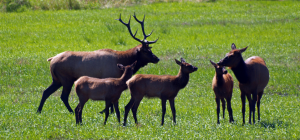WVDL collaborates with DNR on unexplained elk deaths

The Wisconsin Department of Natural Resources (WDNR) is undertaking an effort to reintroduce elk to the central part of the state and to supplement the current herd in Clam Lake. The reintroduction effort is headed by the WDNR and multiple partner organizations. The elk originate from a stable population in Kentucky and this year were moved to, and will ultimately be released in, the central forest region in Jackson County.
In January of 2015, WDNR and Kentucky Department of Fish and Wildlife staff captured and started the health testing and quarantine process to relocate the elk to Wisconsin. The team provided constant oversight of husbandry and animal health, drawing upon previous experience moving elk to other states, such as Missouri and Virginia, from Kentucky.
With heightened awareness and measures to minimize stress, which is very important when handling wildlife, 26 elk arrived safety to a specially built quarantine pen in Jackson County on March 26th, 2015. The elk all appeared well for the first three weeks they were in Wisconsin, but the next week, five animals died acutely. In total, four calves and one cow had died and their bodies transported to WVDL. The gross necropsy offered little evidence for the cause of death with exception of one of the animals that had gross findings consistent with a hemolytic disease process. Drs. Melissa Behr, Christine Watson, Raman Muthuswamy, and Phil Bochsler all worked on the cases.
Extensive diagnostic testing in the virology, bacteriology, and combined molecular biology sections were inconclusive. Through a collaborative effort with Dr. Pat Holman Laboratory at Texas A&M and the Vector Borne Disease Diagnostic Laboratory at North Carolina State University, Babesia odocoilei was diagnosed. This pathogen is a protozoan parasite that infects red blood cells and is spread by ticks.
The red blood cell parasite has been previously reported in North American elk in multiple states and the white tailed deer is considered its predominant reservoir. In Wisconsin, it has been identified in captive elk and reindeer as well as ticks. Treatment is possible, but not straightforward and the next challenge for the elk team and WDNR wildlife veterinarian, Dr. Lindsey Long, is evaluating individual elk susceptibility and appropriate management strategies in a population destined to be free-ranging in the forests of Wisconsin.
To read more about the WDNR’s effort to reintroduce elk into Jackson County, Wisconsin click here: https://dnr.wi.gov/files/PDF/pubs/wm/WM0617.pdf